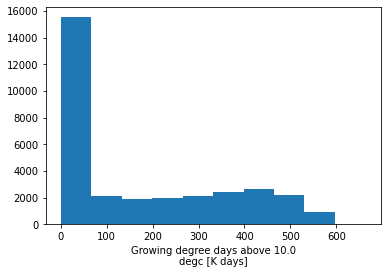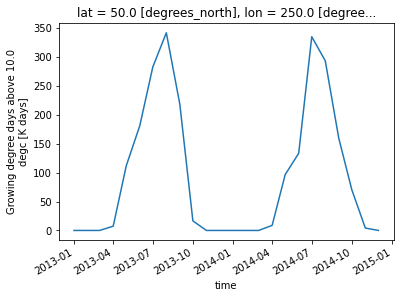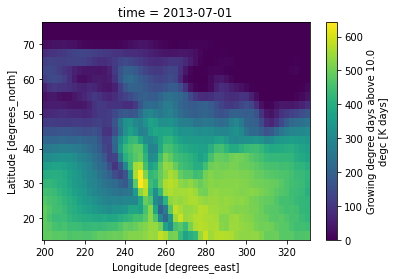Download this notebook from github.
Basic Usage
Climate indicator computations
xclim is a library of climate indicators that operate on xarray DataArray objects.
xclim provides two layers of computations, one responsible for computations and units handling (the computation layer, the indices), and the other responsible for input health checks and metadata formatting (the CF layer, refering to the Climate and Forecast convention, the indicators). Functions from the computation layer are found in xclim.indices, while indicator objects from the CF layer are found in realm modules (xclim.atmos, xclim.land and xclim.seaIce).
Users should always use the indicators, and maybe revert to indices as a last resort if the indicator machinery becomes too heavy for their special edge case.
To use xclim in a project, import both xclim and xarray.
[1]:
import xclim
from xclim.testing import open_dataset
import xarray as xr
Indice calculations are performed by opening a netCDF-like file, accessing the variable of interest, and calling the indice function, which returns a new DataArray.
For this example, we’ll first open a demonstration dataset storing surface air temperature and compute the number of growing degree days (the sum of degrees above a certain threshold) at the monthly frequency.
[2]:
# ds = xr.open_dataset("your_file.nc")
ds = open_dataset("ERA5/daily_surface_cancities_1990-1993.nc")
ds.tas
[2]:
<xarray.DataArray 'tas' (location: 5, time: 1461)>
array([[277.49966, 270.44736, 273.5631 , ..., 259.30075, 267.44043, 264.0009 ],
[272.3179 , 268.01813, 273.50452, ..., 249.57759, 258.23706, 260.20535],
[245.21338, 252.72534, 248.18385, ..., 235.18086, 236.17192, 243.2071 ],
[270.79147, 263.67996, 257.4426 , ..., 257.80548, 269.45105, 261.2271 ],
[279.71753, 278.1774 , 279.41824, ..., 280.08725, 280.65396, 280.92868]],
dtype=float32)
Coordinates:
lat (location) float32 44.5 45.5 63.75 52.0 48.5
* location (location) object 'Halifax' 'Montréal' ... 'Saskatoon' 'Victoria'
lon (location) float32 -63.5 -73.5 -68.5 -106.8 -123.2
* time (time) datetime64[ns] 1990-01-01 1990-01-02 ... 1993-12-31
Attributes:
standard_name: air_temperature
long_name: Mean daily surface temperature
units: K
cell_methods: time: mean within days[3]:
gdd = xclim.atmos.growing_degree_days(tas=ds.tas, thresh="10.0 degC", freq="YS")
gdd
[3]:
<xarray.DataArray 'growing_degree_days' (location: 5, time: 4)>
array([[7.9897247e+02, 7.2488672e+02, 6.4941925e+02, 6.7033386e+02],
[1.2330164e+03, 1.3716892e+03, 1.1340271e+03, 1.2288167e+03],
[8.0615845e+00, 2.7421051e+01, 1.0251160e+00, 2.0045013e+01],
[9.3481873e+02, 1.0134860e+03, 7.2482220e+02, 6.3551764e+02],
[6.2461761e+02, 5.3345679e+02, 6.3453369e+02, 5.9410144e+02]],
dtype=float32)
Coordinates:
* time (time) datetime64[ns] 1990-01-01 1991-01-01 1992-01-01 1993-01-01
lat (location) float32 44.5 45.5 63.75 52.0 48.5
* location (location) object 'Halifax' 'Montréal' ... 'Saskatoon' 'Victoria'
lon (location) float32 -63.5 -73.5 -68.5 -106.8 -123.2
Attributes:
units: K days
cell_methods: time: mean within days time: mean within days time: sum o...
history: [2022-01-28 23:50:29] growing_degree_days: GROWING_DEGREE...
standard_name: integral_of_air_temperature_excess_wrt_time
long_name: Growing degree days above 10.0 degc
description: Annual growing degree days above 10.0 degc.This computation was made using the growing_degree_days indicator. The same computation could be made through the indice. You can see how the metadata is alot poorer here.
[4]:
gdd = xclim.indices.growing_degree_days(tas=ds.tas, thresh="10.0 degC", freq="YS")
gdd
[4]:
<xarray.DataArray 'tas' (location: 5, time: 4)>
array([[7.9897247e+02, 7.2488672e+02, 6.4941925e+02, 6.7033386e+02],
[1.2330164e+03, 1.3716892e+03, 1.1340271e+03, 1.2288167e+03],
[8.0615845e+00, 2.7421051e+01, 1.0251160e+00, 2.0045013e+01],
[9.3481873e+02, 1.0134860e+03, 7.2482220e+02, 6.3551764e+02],
[6.2461761e+02, 5.3345679e+02, 6.3453369e+02, 5.9410144e+02]],
dtype=float32)
Coordinates:
* time (time) datetime64[ns] 1990-01-01 1991-01-01 1992-01-01 1993-01-01
lat (location) float32 44.5 45.5 63.75 52.0 48.5
* location (location) object 'Halifax' 'Montréal' ... 'Saskatoon' 'Victoria'
lon (location) float32 -63.5 -73.5 -68.5 -106.8 -123.2
Attributes:
units: K dThe call to xclim.indices.growing_degree_days first checked that the input variable units were units of temperature, ran the computation, then set the output’s units to the appropriate unit (here K d or kelvin days). As you can see, the indicator returned the same output, but with more metadata, it also performed more checks as explained below.
growing_degree_days makes most sense with daily input, but could theoritically accept other source frequencies. The computational layer (indice) assumes that users have checked that the input data has the expected temporal frequency and has no missing values. However, no checks are performed, so the output data could be wrong. That’s why it’s always safer to use ``Indicator`` objects from the CF layer, as done in the following section.
New unit handling paradigm in xclim 0.24 for indices
As of xclim 0.24, the paradigm in unit handling has changed slightly. Now, indices are written in order to be more flexible as to the sampling frequency and units of the data. You can use growing_degree_days on, for example, the 6-hourly data. The ouput will then be in degree-hour units (K h). Moreover, all units, even when untouched by the calculation, will be reformatted to a CF-compliant symbol format. This was made to ensure consistency between all indices.
Very few indices will convert their output to a specific units, rather it is the dimensionality that will be consistent. The Unit handling page goes in more details on how unit conversion can easily be done.
This doesn’t apply to Indicators. Those will always output data in a specific unit, the one listed in the Indicators.cf_attrs metadata dictionnary.
Finally, as almost all indices, the function takes a freq argument to specify over what time period it is computed. These are called “Offset Aliases” and are the same as the resampling string arguments. Valid arguments are detailed in panda’s doc (note that aliases involving “business” notions are not supported by xarray and thus could raises issues in xclim.
Health checks and metadata attributes
Indicator instances from the CF layer are found in modules bearing the name of the computational realm in which its input variables are found: xclim.atmos, xclim.land and xclim.seaIce. These objects from the CF layer run sanity checks on the input variables and set output’s metadata according to CF-convention when they apply. Some of the checks involve:
Identifying periods where missing data significantly impacts the calculation and omits calculations for those periods. Those are called “missing methods” and are detailed in section Health checks.
Appending process history and maintaining the historical provenance of file metadata.
Writing Climate and Forecast Convention compliant metadata based on the variables and indices calculated.
Those modules are best used for producing NetCDF that will be shared with users. See Climate Indicators for a list of available indicators.
If we run the growing_degree_days indicator over a non daily dataset, we’ll be warned that the input data is not daily. That is, running xclim.atmos.growing_degree_days(ds.air, thresh='10.0 degC', freq='MS') will fail with a ValidationError:
[5]:
ds6h = xr.tutorial.open_dataset("air_temperature")
gdd = xclim.atmos.growing_degree_days(ds6h.air, thresh="10.0 degC", freq="MS")
---------------------------------------------------------------------------
ValueError Traceback (most recent call last)
ValueError: Frequency of time series not strictly in ['D']. To mute this, set xclim's option data_validation='log'.
The above exception was the direct cause of the following exception:
ValidationError Traceback (most recent call last)
/tmp/ipykernel_720/3753143723.py in <module>
1 ds6h = xr.tutorial.open_dataset("air_temperature")
----> 2 gdd = xclim.atmos.growing_degree_days(ds6h.air, thresh="10.0 degC", freq="MS")
~/checkouts/readthedocs.org/user_builds/xclim/envs/v0.33.0/lib/python3.7/site-packages/xclim/core/indicator.py in __call__(self, *args, **kwds)
774 das, params = self._parse_variables_from_call(args, kwds)
775
--> 776 das, params = self._preprocess_and_checks(das, params)
777
778 # Get correct variable names for the compute function.
~/checkouts/readthedocs.org/user_builds/xclim/envs/v0.33.0/lib/python3.7/site-packages/xclim/core/indicator.py in _preprocess_and_checks(self, das, params)
1373 def _preprocess_and_checks(self, das, params):
1374 """Perform parent's checks and also check if freq is allowed."""
-> 1375 das, params = super()._preprocess_and_checks(das, params)
1376
1377 indxr = params.get("indexer")
~/checkouts/readthedocs.org/user_builds/xclim/envs/v0.33.0/lib/python3.7/site-packages/xclim/core/indicator.py in _preprocess_and_checks(self, das, params)
1307 def _preprocess_and_checks(self, das, params):
1308 """Perform parent's checks and also check if freq is allowed."""
-> 1309 das, params = super()._preprocess_and_checks(das, params)
1310
1311 # Check if the period is allowed:
~/checkouts/readthedocs.org/user_builds/xclim/envs/v0.33.0/lib/python3.7/site-packages/xclim/core/indicator.py in _preprocess_and_checks(self, das, params)
884 """Actions to be done after parsing the arguments and before computing."""
885 # Pre-computation validation checks on DataArray arguments
--> 886 self._bind_call(self.datacheck, **das)
887 self._bind_call(self.cfcheck, **das)
888
~/checkouts/readthedocs.org/user_builds/xclim/envs/v0.33.0/lib/python3.7/site-packages/xclim/core/indicator.py in _bind_call(self, func, **das)
922 else:
923 # Call the func using bound arguments
--> 924 return func(*ba.args, **ba.kwargs)
925
926 @classmethod
~/checkouts/readthedocs.org/user_builds/xclim/envs/v0.33.0/lib/python3.7/site-packages/xclim/core/indicator.py in datacheck(self, **das)
1220 for key, da in das.items():
1221 if "time" in da.coords and da.time.ndim == 1 and len(da.time) > 3:
-> 1222 datachecks.check_freq(da, self.src_freq, strict=True)
1223
1224 def __getattr__(self, attr):
<boltons.funcutils.FunctionBuilder-151> in check_freq(var, freq, strict)
~/checkouts/readthedocs.org/user_builds/xclim/envs/v0.33.0/lib/python3.7/site-packages/xclim/core/options.py in run_check(*args, **kwargs)
114 @wraps(func)
115 def run_check(*args, **kwargs):
--> 116 return _run_check(func, DATA_VALIDATION, *args, **kwargs)
117
118 return run_check
~/checkouts/readthedocs.org/user_builds/xclim/envs/v0.33.0/lib/python3.7/site-packages/xclim/core/options.py in _run_check(func, option, *args, **kwargs)
106 func(*args, **kwargs)
107 except ValidationError as err:
--> 108 raise_warn_or_log(err, OPTIONS[option], stacklevel=4)
109
110
~/checkouts/readthedocs.org/user_builds/xclim/envs/v0.33.0/lib/python3.7/site-packages/xclim/core/utils.py in raise_warn_or_log(err, mode, msg, err_type, stacklevel)
454 warnings.warn(msg, stacklevel=stacklevel + 1)
455 else: # mode == "raise"
--> 456 raise err from err_type(msg)
457
458
~/checkouts/readthedocs.org/user_builds/xclim/envs/v0.33.0/lib/python3.7/site-packages/xclim/core/options.py in _run_check(func, option, *args, **kwargs)
104 """Run function and customize exception handling based on option."""
105 try:
--> 106 func(*args, **kwargs)
107 except ValidationError as err:
108 raise_warn_or_log(err, OPTIONS[option], stacklevel=4)
~/checkouts/readthedocs.org/user_builds/xclim/envs/v0.33.0/lib/python3.7/site-packages/xclim/core/datachecks.py in check_freq(var, freq, strict)
45 ):
46 raise ValidationError(
---> 47 f"Frequency of time series not {'strictly' if strict else ''} in {freq}. "
48 "To mute this, set xclim's option data_validation='log'."
49 )
ValidationError: Frequency of time series not strictly in ['D']. To mute this, set xclim's option data_validation='log'.
Resampling to a daily frequency and running the same indicator succeeds, but we still get warnings from the CF metadata checks.
[6]:
daily_ds = ds6h.resample(time="D").mean(keep_attrs=True)
gdd = xclim.atmos.growing_degree_days(daily_ds.air, thresh="10.0 degC", freq="YS")
/home/docs/checkouts/readthedocs.org/user_builds/xclim/envs/v0.33.0/lib/python3.7/site-packages/xclim/core/cfchecks.py:40: UserWarning: Variable does not have a `cell_methods` attribute.
getattr(vardata, "cell_methods", None), data["cell_methods"]
/home/docs/checkouts/readthedocs.org/user_builds/xclim/envs/v0.33.0/lib/python3.7/site-packages/xclim/core/cfchecks.py:43: UserWarning: Variable does not have a `standard_name` attribute.
check_valid(vardata, "standard_name", data["standard_name"])
To suppress the CF validation warnings in the following, we will set xclim to send them to the log, instead of raising a warning or an error. We also could have set data_validation='warn' to be able to run the indicator on non-daily data. These options are set globally or within a context with set_options.
The missing method which determines if a period should be considered missing or not can be controlled through the check_missing option, globally or contextually. The main missing methods also have options that can be modified.
[7]:
with xclim.set_options(
check_missing="pct",
missing_options={"pct": dict(tolerance=0.1)},
cf_compliance="log",
):
# Change the missing method to "percent", instead of the default "any"
# Set the tolerance to 10%, periods with more than 10% of missing data
# in the input will be masked in the ouput.
gdd = xclim.atmos.growing_degree_days(daily_ds.air, thresh="10.0 degC", freq="MS")
Some indicators also expose time-selection arguments as **indexer keywords. This allows to run the indice on a subset of the time coordinates, for example only on a specific season, month, or between two dates in every year. It relies on the select_time function. Some indicators will simply select the time period and run the calculations, while others will smartly perform the selection at the right time, when the order of operation
makes a difference. All will pass the indexer kwargs to the missing value handling ensuring that the missing values outside the valid time period are not considered.
The next example computes the annual sum of growing degree days over 10 °C, but only considering days from the 1st of April to the 30th of September.
[8]:
with xclim.set_options(cf_compliance="log"):
gdd = xclim.atmos.growing_degree_days(
tas=daily_ds.air, thresh="10 degC", freq="YS", date_bounds=("04-01", "09-30")
)
gdd
[8]:
<xarray.DataArray 'growing_degree_days' (time: 2, lat: 25, lon: 53)>
array([[[0.0000000e+00, 0.0000000e+00, 0.0000000e+00, ...,
0.0000000e+00, 0.0000000e+00, 0.0000000e+00],
[0.0000000e+00, 0.0000000e+00, 0.0000000e+00, ...,
0.0000000e+00, 0.0000000e+00, 0.0000000e+00],
[3.3140015e+01, 5.0820099e+01, 6.6547607e+01, ...,
0.0000000e+00, 0.0000000e+00, 0.0000000e+00],
...,
[2.7736938e+03, 2.6248127e+03, 2.5183259e+03, ...,
2.6201809e+03, 2.5202236e+03, 2.4362007e+03],
[2.8073425e+03, 2.7539409e+03, 2.6544858e+03, ...,
2.6141130e+03, 2.6077131e+03, 2.5585962e+03],
[2.8185554e+03, 2.8164487e+03, 2.7658499e+03, ...,
2.6862107e+03, 2.6818704e+03, 2.6931643e+03]],
[[0.0000000e+00, 0.0000000e+00, 0.0000000e+00, ...,
0.0000000e+00, 0.0000000e+00, 0.0000000e+00],
[0.0000000e+00, 0.0000000e+00, 0.0000000e+00, ...,
0.0000000e+00, 0.0000000e+00, 0.0000000e+00],
[1.0225220e+00, 5.5400085e+00, 1.0475037e+01, ...,
0.0000000e+00, 0.0000000e+00, 0.0000000e+00],
...,
[2.8183235e+03, 2.6905312e+03, 2.6107827e+03, ...,
2.5506511e+03, 2.4474639e+03, 2.3652024e+03],
[2.8695332e+03, 2.8242588e+03, 2.7269099e+03, ...,
2.5259944e+03, 2.5199478e+03, 2.4677590e+03],
[2.8881079e+03, 2.8856880e+03, 2.8283704e+03, ...,
2.5869858e+03, 2.5948555e+03, 2.6111182e+03]]], dtype=float32)
Coordinates:
* time (time) datetime64[ns] 2013-01-01 2014-01-01
* lat (lat) float32 75.0 72.5 70.0 67.5 65.0 ... 25.0 22.5 20.0 17.5 15.0
* lon (lon) float32 200.0 202.5 205.0 207.5 ... 322.5 325.0 327.5 330.0
Attributes:
units: K days
cell_methods: time: mean within days time: sum over days
history: [2022-01-28 23:50:31] growing_degree_days: GROWING_DEGREE...
standard_name: integral_of_air_temperature_excess_wrt_time
long_name: Growing degree days above 10 degc
description: Annual growing degree days above 10 degc.Finally, xclim also allows to call indicators using datasets and variable names.
[9]:
with xclim.set_options(cf_compliance="log"):
gdd = xclim.atmos.growing_degree_days(
tas="air", thresh="10.0 degC", freq="MS", ds=daily_ds
)
# variable names default to xclim names, so we can even do this:
renamed_daily_ds = daily_ds.rename(air="tas")
gdd = xclim.atmos.growing_degree_days(
thresh="10.0 degC", freq="MS", ds=renamed_daily_ds
)
Graphics
[10]:
import matplotlib.pyplot
%matplotlib inline
# Summary statistics histogram
gdd.plot()
[10]:
(array([15532., 2079., 1861., 1935., 2137., 2416., 2675., 2202.,
931., 32.]),
array([ 0. , 66.32573, 132.65146, 198.9772 , 265.30292, 331.62866,
397.9544 , 464.28012, 530.60583, 596.9316 , 663.2573 ],
dtype=float32),
<BarContainer object of 10 artists>)

[11]:
# Show time series at a given geographical coordinate
gdd.isel(lon=20, lat=10).plot()
[11]:
[<matplotlib.lines.Line2D at 0x7f3c05e81350>]

[12]:
# Show spatial pattern at a specific time period
gdd.sel(time="2013-07").plot()
[12]:
<matplotlib.collections.QuadMesh at 0x7f3c05b28fd0>

For more examples, see the directions suggested by xarray’s plotting documentation
To save the data as a new NetCDF, use to_netcdf.
[13]:
gdd.to_netcdf("monthly_growing_degree_days_data.nc")
It’s possible to save Dataset objects to other file formats. For more information see: xarray’s documentation